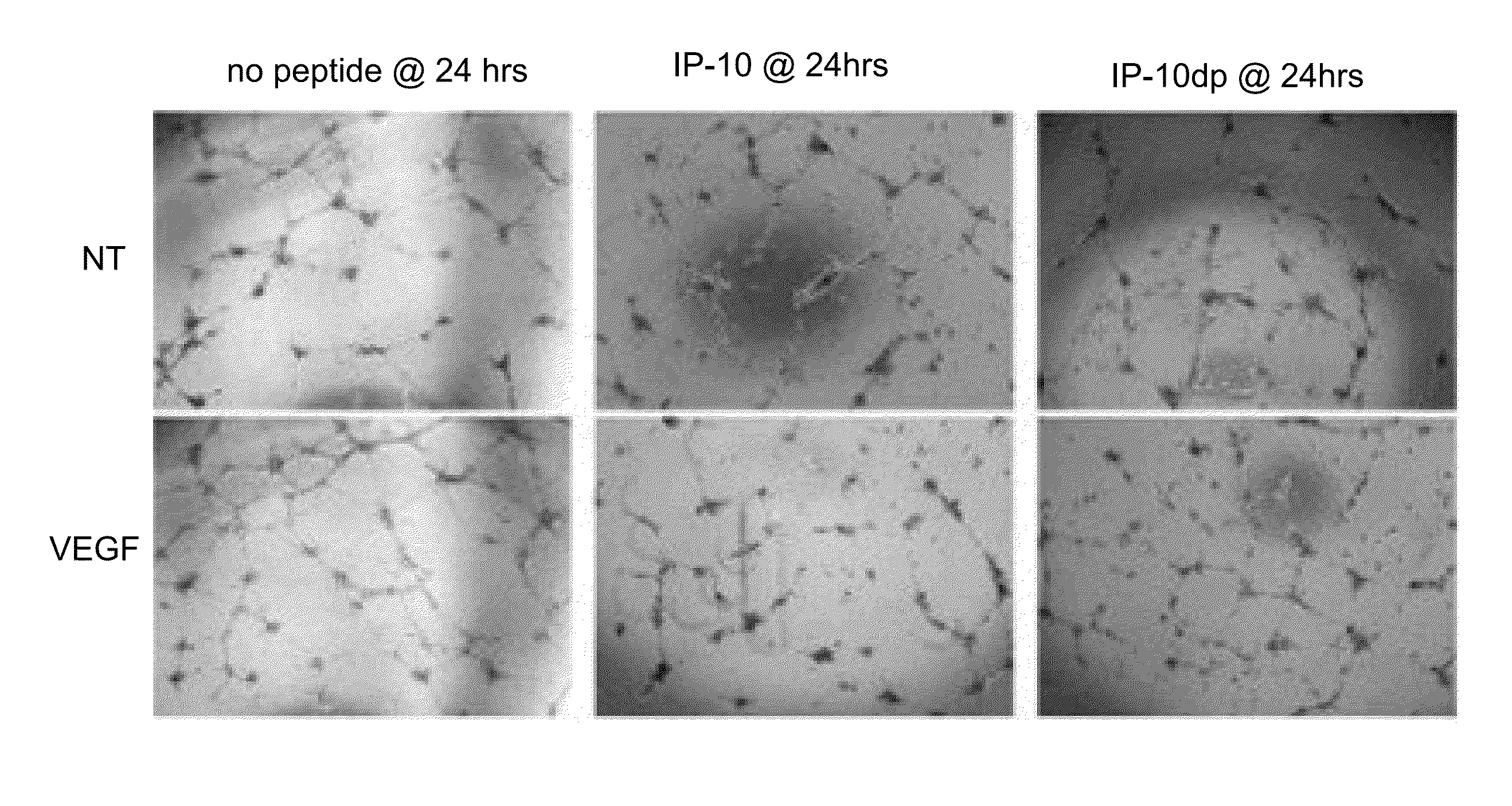Chemokine derived peptides and uses for chronic wound and angiogenesis inhibition treatments
- Summary
- Abstract
- Description
- Claims
- Application Information
AI Technical Summary
Benefits of technology
Problems solved by technology
Method used
Image
Examples
experiment 1
[0060
[0061]To determine whether IP-10dp binds to CXCR3 on human dermal microvascular endothelial cells, we analyzed the ability of Sulfo-LC-Biotin tagged IP-10 and IP-10dp to bind to H MEC-1 cells using flow cytometery. As noted above, HMEC-1 cells express CXCR3, and IP-10 is known to binds to CXCR3 in a functional angiostatic capacity. In this experiment, HMEC-1 cells were plated, detached, and fixed in 2% formaldehyde-Hank's balanced salt solution. IP-10 and IP-10dp was labeled using LC-biotin tags. The cells were then incubated with FITC conjugated with streptavidin, and then analyzed on a BD FACSCalbur flow cytometer. FIG. 2 is a graph reporting results from this experiment by comparing the binding of IP-10 and IP-10dp to the HMEC-1 cells.
[0062]As shown in the graph of FIG. 2, the data from this experiment showed that, relative to control, IP-10dp has a slightly lower fluorescence intensity of binding to CXCR3 on the HMEC-1 cells than that for full length LP-10. This lower fluor...
experiment 2
[0063
[0064]To determine whether IP-10dp inhibits endothelial cell motility, a conventional “scratch assay” was performed. ELR-negative chemokines, such as IP-10, inhibit fibroblast and endothelial cell motility. IP-10 has been shown in prior literature to inhibit HMEC-1 cells' motility in the presence of angiogenic growth factors VEGF165 and bFGF. Thus, a scratch assay comparison was conducted to examine whether, and to what extent, IP-10dp could mimic the inhibitory effects of the full length IP-10. HMEC-1 cells were plated at 2.5×105 cells / well in 12 well culture plates and grown to 80 to 85% confluence and quiesced in 0.5% dialyzed fetal bovine serum for 24 hours at 37° C. in 5% CO2. The cells were washed one time with PBS and then incubated in 0.5% dialyzed MDCB 131 media for 24 hours at 37° C. in 5% CO2. The cultures were scraped with a rubber policeman making a 1 mm wide denuded area. The cells were then incubated in 0.5% dialyzed either alone (i.e., a control labeled as “NT,”...
experiment 3
[0066
[0067]As noted above, ELR-negative chemokines have been shown to limit vascularity by regulating the ability of endothelial cells to form vessels in vitro. To determine whether the IP-10 peptide is able to inhibit tube formation, HMEC-1 cells were grown on growth factor reduced (“GFR”) Matrigel in the presence of VEGF165, IP-10 and / or IP-10dp and the cultures inspected and compared to asses the relative degree of tube formation according to the following procedure. GFR Matrigel 10 μl / well (μ-angiogenesis slide, Ibidi), was incubated for 15 minutes at 37° C. HMEC-1 cells (10,000 cells / well) were re-suspended in 1.0% FBS MDCB131 media containing VEGF (75 ng / ml), IP-10 (300 ng / ml) and IP-10dp (10 μM) and or anti-CXCR3 neutralizing antibody. Treated cells (1×104 cells / well) were added to 24-well culture plates coated with growth factor reduced Matrigel and incubated for 24 hours at 37° C. to allow tube formation. The media was then removed and replaced with 1.0% FBS MCDB131 media c...
PUM
| Property | Measurement | Unit |
|---|---|---|
| Fraction | aaaaa | aaaaa |
| Length | aaaaa | aaaaa |
| Area | aaaaa | aaaaa |
Abstract
Description
Claims
Application Information
 Login to View More
Login to View More - R&D
- Intellectual Property
- Life Sciences
- Materials
- Tech Scout
- Unparalleled Data Quality
- Higher Quality Content
- 60% Fewer Hallucinations
Browse by: Latest US Patents, China's latest patents, Technical Efficacy Thesaurus, Application Domain, Technology Topic, Popular Technical Reports.
© 2025 PatSnap. All rights reserved.Legal|Privacy policy|Modern Slavery Act Transparency Statement|Sitemap|About US| Contact US: help@patsnap.com



